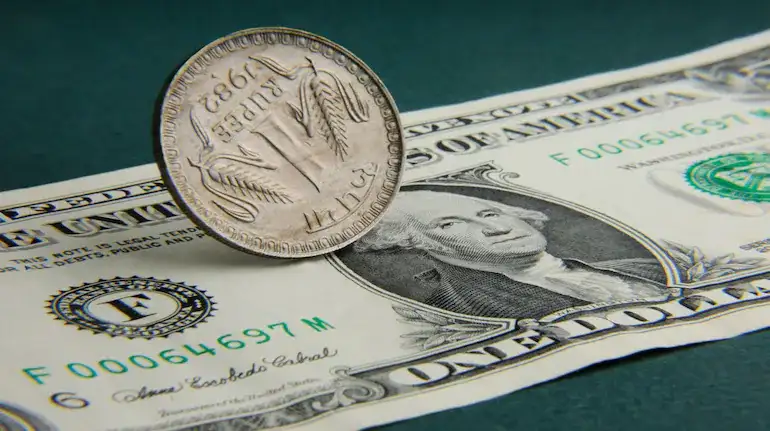Indian Rupee Recovers After Brief Dip, Opens 25 Paise Stronger at 85.30 Against the Dollar
After a slight setback in the previous trading session, the Indian rupee opened on a positive note Friday, gaining 25 paise to trade at 85.30 against the US dollar. This uptick follows Thursday’s close at 85.55, where the domestic currency had ended lower amid global market uncertainty and rising crude prices.

Rebound Signals Market Optimism
Friday’s early recovery points to improved market sentiment and a subtle pullback in the US dollar index. The rebound has brought temporary relief to traders and import-heavy sectors, which had begun to feel the pinch of the rupee’s recent weakness.
Currency dealers believe the rupee’s morning gains were supported by dollar inflows, possibly from exporters and foreign institutional investors, along with signs that the Reserve Bank of India (RBI) may have intervened in the forex market to stabilize the currency.
“The rupee gained ground as the dollar index softened slightly and exporter activity picked up. Also, there’s a strong possibility that the RBI stepped in to prevent excessive depreciation,” said a senior trader at a public sector bank.
Global Influences on Currency Movement
A key factor impacting the rupee’s direction has been the strength of the US dollar, driven by expectations that the Federal Reserve may delay any interest rate cuts due to solid economic indicators in the US.
However, during overnight trade, the greenback lost some momentum, helping currencies like the rupee to recover slightly.
At the same time, crude oil prices remain elevated, which is a concern for India—a country that imports the vast majority of its oil. Expensive crude can widen the trade deficit, making it harder for the rupee to stay firm.
Central Bank’s Silent Role
Although the RBI does not usually comment on its currency market operations, traders say recent movements hint at the central bank’s behind-the-scenes involvement. By selling dollars at strategic points, the RBI may be trying to prevent the rupee from breaching critical levels.
This approach aims to ensure financial stability, especially with the country navigating election season and a shifting global economic environment.
“The central bank appears to be defending the 85.50 mark. Their intervention sends a strong signal that sharp volatility won’t be tolerated,” noted a forex strategist at a Mumbai-based investment firm.
Impact on Trade and Business
Fluctuations in the rupee’s value have a direct effect on businesses engaged in international trade. A stronger rupee can benefit importers by lowering the cost of foreign goods, while exporters may earn less when converting their overseas income.
With today’s recovery, some exporters may consider converting their dollar earnings to take advantage of favorable exchange rates. On the flip side, importers could use this window to hedge against future risks, given the unpredictable nature of global markets.
What to Expect Going Forward?
Analysts expect the rupee to remain sensitive to both global and domestic developments in the coming weeks. Several key factors will determine its short-term trajectory:
- Federal Reserve policy outlook: Any signal of interest rate hikes or delays in cuts could strengthen the dollar.
- Crude oil trends: Higher prices could weigh on the rupee by increasing India’s import bill.
- India’s economic data: Inflation, industrial output, and trade figures will guide sentiment.
- Foreign investments: Inflows or outflows from equity and debt markets will also play a crucial role.
“The rupee is likely to trade between 84.80 and 85.60 in the near term. While the fundamentals remain stable, global risk factors could drive short bursts of volatility,” said an economist at a leading financial consultancy.
Ripple Effect on Stock Markets
A stable or strengthening rupee often boosts stock market confidence, especially in sectors dependent on imports. Friday’s currency gains were reflected in early trading on Indian stock exchanges, with benchmark indices showing mild upward momentum.
Market participants believe currency stability could help sustain foreign investor interest in Indian equities, which have seen mixed activity in recent sessions.
A Delicate Balance
While today’s opening suggests a recovery, the rupee remains in a fragile spot amid uncertain global conditions. The RBI’s efforts to maintain stability, along with consistent macroeconomic data, are likely to shield the currency from sharp declines in the short term.
However, any sudden geopolitical developments, commodity price spikes, or shifts in investor sentiment could still trigger fluctuations.
Conclusion
The Indian rupee’s 25 paise gain against the US dollar after a brief decline highlights the ongoing tug-of-war between external pressures and domestic support measures. While the path ahead remains uncertain, Friday’s opening at 85.30 is a positive signal that the rupee continues to find strength when needed.
With the Reserve Bank’s quiet but steady oversight and improving investor confidence, the rupee may avoid drastic swings, even in a globally volatile environment. For now, both traders and businesses will keep a close eye on developments, knowing that in today’s interconnected world, every data point can shift the balance.






